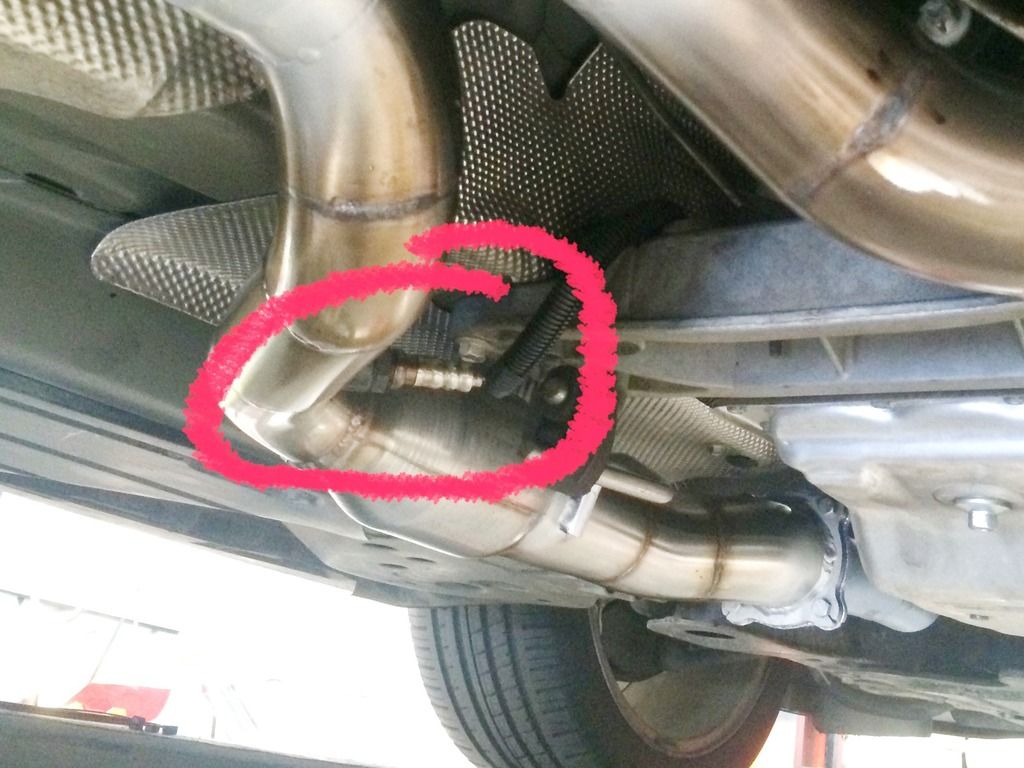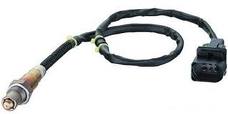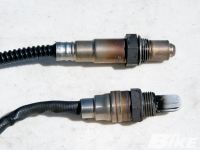Home›Forums›Technical – General›Tech Articles, Links & Calculators›Ideal O2 Sensor Mounting
This topic contains 16 replies, has 5 voices, and was last updated by ![]() VRSenator065 8 years, 5 months ago.
VRSenator065 8 years, 5 months ago.
-
AuthorPosts
-
November 10, 2015 at 1:58 pm #11097

VRSenator065Participant- Adelaide SA
- VR Senator LSx454 1960 Kombi (project) 1921 Nash Hot Rod (future project)
View build HERE
Posts: 5 777
Great article thanks to Sands VS;
http://wbo2.com/lsu/position.htm
Have a read there re placement, has to be fitted in certain angle etc. To drain moisture etc
10-15 degree
The image shows the range of acceptable mounting positions. A vertical position can get too hot in confined spaces, so we recommend at least 15 degrees from the vertical. The horizontal position can cause condensation to drip onto the sensor, so we recommend at least 10 degrees from the horizontal. In all cases the sensor should be perpendicular to the gas flow, ie. the bung should sit square over the pipe – this ensures adequate but not an excessive amount of gas enters the sensor.
We recommend placing the sensor around 1 m (40″) from the closest exhaust valve. Where this cannot be achieved then spacing the sensor away from the direct exhaust by using a longer M18x1.5 bung, or a nut welded over a standard bung, is recommended.
° towards horizontal which prevents the collection of liquids between sensor housing and sensor element during the cold start phase. Proper bung placement and sensor installation are vital, otherwise sensor accuracy and lifespan can be affected.The image shows the range of acceptable mounting positions. A vertical position can get too hot in confined spaces, so we recommend at least 15 degrees from the vertical. The horizontal position can cause condensation to drip onto the sensor, so we recommend at least 10 degrees from the horizontal. In all cases the sensor should be perpendicular to the gas flow, ie. the bung should sit square over the pipe – this ensures adequate but not an excessive amount of gas enters the sensor.
November 10, 2015 at 11:59 pm #11103
pir4teParticipant- Mallala
- 640 HP hyper-cruising SS-V Flagonwagon
View build HERE
Posts: 154

This look about right?
Naturally as-pirated, all-motor.
November 11, 2015 at 8:21 am #11106Always been told after the cats is wrong, been tempted to run one before and one after to see if this is a myth.
November 11, 2015 at 8:53 am #11107
VRSenator065Participant- Adelaide SA
- VR Senator LSx454 1960 Kombi (project) 1921 Nash Hot Rod (future project)
View build HERE
Posts: 5 777
I remember reading the latest Cars/ECU’s use one before and after so they can make sure the cats are doing their thing?
-
This reply was modified 8 years, 5 months ago by
 VRSenator065.
VRSenator065.
November 11, 2015 at 10:00 am #11115I remember reading the latest Cars/ECU’s use one before and after so they can make sure the cats are doing their thing?
The effect of a converter working correctly in a production car can be seen by examining the operation of a pre and post converter sensor; these are conventional oxygen sensors, not broad-band. The rear sensor clearly does not follow the front sensor that’s cycling in time with the ECU altering the mixture. It almost reads a constant value and this shows correct operation of the system.
The rear sensor can be made to alter it’s voltage by simply snapping the throttle open and therefore commanding a rich mixture. The catalyst does not work efficiently under the rich gas and therefore the rear sensor starts to read rich (high output), the same happens under deceleration when the injection is cut and the mixture goes lean (low output). Note the delays between the front and rear sensor readings; it is all to do with oxygen storage of the converter and the changing gas chemistry.
What is lambda, and the difference between narrow band and wide band 02 sensors?
One the most important aspects of the combustion motor is the air to fuel ratio in the cylinder. Like all things that explode, having the proper amount of combustible fuel to the amount of air to sustain the burn is important. Having lots of air but no fuel will cause the combustion to burn very rapidly and hot, while having lots of fuel, but no air will cause the mixture to burn very cool and slowly. Having an overly gross amount of either fuel or air will cause the combustion to not even occur at all.What is Lambda? =
Lambda is scale that relates the air to fuel ratio of ANY fuel. 1.0 is stoic for every fuel. (the chemically perfect ratio of air to fuel for a complete burn). However, stoic is different for every fuel. Some fuels may need 14.7 lbs of air some may need 6 lbs of air for a complete burn. Lambda 1.0 is always the perfect ratio for the fuel in use.Some tuners argue that it is better to read air to fuel ratio’s in lambda since it will be accurate with any fuel. To be fair though, most aftermarket gauges will read lambda and convert that number to an a/f ratio for gasoline. If the user then knows the stoic, lean, and rich ratio’s for gasoline, he can apply those numbers to any fuel used and it won’t matter.
What I mean is that if you are running 14.7 (stoic) on a gasoline A/F gauge and you then convert to alcohol ( or E85 ), 14.7 will still be stoic on the gasoline gauge. This is because the gauge is going to read a stoic lambda reading of 1.0 for any fuel, and the gauge is going to output that number as 14.7 on you’re A/F gauge even though we know the true ratio for alcohol is 7.1-9.1.
Many times I have then seen people try and richen the cars tuning map to get down to that A/F value, not realizing that they are already at a stoic burn if the gauge set up for gasoline reads 14.7.
Narrow Band vs Wide Band o2 Sensors

A narrow band o2 sensor is an oxygen sensor that is only calibrated to know three things. Rich, stoic, and lean. What I mean by this is that it only has a narrow window that it see’s the air fuel mixture through. The sensor can tell the computer when it’s stoic. If it’s not stoic, it can tell the ECU that it’s either Rich, or Lean, but that’s it. It doesn’t really output any particular value other than that. How rich the car is the sensor has NO IDEA about. Same with how lean the car is. All it does know is that it’s not stoic. The ecu with a narrowband o2 sensor, when in closed loop mode, will then lean on the fuel map if it is receiving a rich signal from the o2 sensor till its stoic. The opposite would be true if the sensor was telling the ECU that it was currently running lean, it would richen the fuel map till the o2 sensor was reading stoic.
A wideband o2 sensor is much more sophisticated than a narrowband sensor, and can be relied upon to be used as a tuning tool. Wideband sensors not only are a lot faster acting in the reading, but can tell you the exact a/f ratio that the motor is currently at. So instead of just telling the ECU that the motor is running rich, it will read a voltage that correlates to an actual value, like 11.2. One thing to remember with a wideband sensor is that it has a heating element that needs to be heated up before the sensor will be accurate in its readings. This usually only takes a few seconds, but just remember that for those first few seconds the gauge is not useful. Wideband sensors give the ECU the ability to tune exact A/F value’s to a tenth of a decimal instead of just richening and leaning the mixture till a stoic value is seen.
-
This reply was modified 8 years, 5 months ago by
 sands vs.
sands vs.
-
This reply was modified 8 years, 5 months ago by
 sands vs.
sands vs.
-
This reply was modified 8 years, 5 months ago by
 sands vs.
sands vs.
-
This reply was modified 8 years, 5 months ago by
 sands vs.
sands vs.
-
This reply was modified 8 years, 5 months ago by
 sands vs.
sands vs.
-
This reply was modified 8 years, 5 months ago by
 sands vs.
sands vs.
-
This reply was modified 8 years, 5 months ago by
 sands vs.
sands vs.
November 11, 2015 at 10:03 am #11120I remember reading the latest Cars/ECU’s use one before and after so they can make sure the cats are doing their thing?
Yeah the Tonner has Pre and Post, all part of meeting emissions, both 4 wire NB sensors but slightly different, NFI what’s going on there..
A lot of people disable them in the tune with no adverse effects, I did this in the Lexcen as I don’t run cats at all in it.
November 11, 2015 at 12:54 pm #11127being so far away from the exhaust port, they need heaters to keep them at the correct operating temperature. The pre/post o2 sensor combo is part of the catalyst efficiency algorithm. Aside from any processing the CATs may do to the exhaust gas, the further away from the port you are, the more lag you get and chance of leaks etc. affecting the reading.
I always fit pre-cat if possible, at the end of the day though we have to be practical about how we set it up. If you are tuning to what the engine wants rather than a fixed number then a few points AFR difference probably isn’t going to be an issue unless you are doing OEM tuning
November 11, 2015 at 4:09 pm #11128
VRSenator065Participant- Adelaide SA
- VR Senator LSx454 1960 Kombi (project) 1921 Nash Hot Rod (future project)
View build HERE
Posts: 5 777
If you are tuning to what the engine wants rather than a fixed number….
Interesting to see you write that, as my tuner says that’s what he focuses on, working out what the actual engine he is tuning wants, then giving that to it. That’s one of the reason he didn’t want to go to far with mine at my place when I did the injector swap. He said he wants it in his workshop on the rollers and he wants to use his full gas analyzer (you guys I am sure know more about what that’s actually called than me) so he has an exact idea of what’s happening in the combustion process in my engine, and tune to that. Seemed a good approach to me but I am definitely NOT “Mr Tuner”
November 11, 2015 at 7:32 pm #11135
pir4teParticipant- Mallala
- 640 HP hyper-cruising SS-V Flagonwagon
View build HERE
Posts: 154
Always been told after the cats is wrong, been tempted to run one before and one after to see if this is a myth.
Yeah from efilive site worst case scenario is 1%-2% (0.01-0.02) and others swear nothing. Every tuner I’ve met uses contraption after the muffler in the tips.
Naturally as-pirated, all-motor.
November 11, 2015 at 7:51 pm #11136Yeah from efilive site worst case scenario is 1%-2% (0.01-0.02) and others swear nothing. Every tuner I’ve met uses contraption after the muffler in the tips.
Cool, would be interesting to do a test and see just what the difference is in the real world but it’s going to be different for every combination I guess depending on Cat type and age, if those numbers are accurate at all it’s below the +- of most consumer level equipment to measure anyway..
November 12, 2015 at 10:15 am #11151Yeah from efilive site worst case scenario is 1%-2% (0.01-0.02) and others swear nothing. Every tuner I’ve met uses contraption after the muffler in the tips.
Cool, would be interesting to do a test and see just what the difference is in the real world but it’s going to be different for every combination I guess depending on Cat type and age, if those numbers are accurate at all it’s below the +- of most consumer level equipment to measure anyway..
you would also need to factor in timelag if transient state, also response time of sensors and controller as well as output filtering (filtering transitent signal). Some of this can be removed if testing in true steady state but then you also have analogue offset in each wideband controller as well as the measurement device. Everything has to be calculated etc. when you look at the resolution across the full scale (10 to 20 AFR, 0-5V) as well as the DAC of the output stage in the wideband… you wonder if you people are chasing ghosts.
I doubt you will see a tangible diff in mixture at WOT however with tailpipe measurement you will definitely see a noticeable lag as well as influence of any leaks along the exhaust. Tuners use tailpipe as its easy and clean… otherwise you have to setup on a hoist or jack up, then contend with the sometimes rusty bungs etc. That said, I always go pre cat if possible and allow an extra hr or so for setup and removal time. Makes for a much better result.
November 12, 2015 at 11:50 am #11156
VRSenator065Participant- Adelaide SA
- VR Senator LSx454 1960 Kombi (project) 1921 Nash Hot Rod (future project)
View build HERE
Posts: 5 777
As an electronics guy (in a previous life) I get the lag due to distance and I assume its introducing hysteresis into the feed back loop? So what I think your saying is as long as the tuner is ramping the throttle up or down relatively “slowly/gently” for want of a better word then tailpipe would be fine and match the sensor if it were nearer the heads. But if you were looking at what its doing at say the hit of the throttle the lag can introduce a problem?
November 12, 2015 at 12:02 pm #11157I was always under the impression that after the cats was also bad as it cleans up things and can give an inaccurate reading?
November 12, 2015 at 12:45 pm #11163
pir4teParticipant- Mallala
- 640 HP hyper-cruising SS-V Flagonwagon
View build HERE
Posts: 154
I was always under the impression that after the cats was also bad as it cleans up things and can give an inaccurate reading?
Same, with “really effective” cats in place there is some argument whether readings would have positive or negative effect post cats even (I believe there is less free O2 – richer than pre).
Threads in efilive, LS1, and turbo forums thrash out that theres less than 4/5th (approx) of bugger all in it.
Naturally as-pirated, all-motor.
November 12, 2015 at 1:03 pm #11165Interesting always great to learn cheers. Im running magnaflow metal core 200 cells cats unsure how well they work as far as cleaning up things. Heard they were pretty tuff I have had ceramic cats fail in the past
November 12, 2015 at 4:29 pm #11188As an electronics guy (in a previous life) I get the lag due to distance and I assume its introducing hysteresis into the feed back loop? So what I think your saying is as long as the tuner is ramping the throttle up or down relatively “slowly/gently” for want of a better word then tailpipe would be fine and match the sensor if it were nearer the heads. But if you were looking at what its doing at say the hit of the throttle the lag can introduce a problem?
well not even ramping, just holding at a certain load point till it stabilises to get a reliable reading at the tailpipe. Unfortunately when you do that at higher power levels things start heat soaking rapidly etc. so its a moving goal post.
Its not really a closed loop, as the feedback isn’t used for any input apart from determining a correction factor.
a big part of driveability is transient response, hard to get any indication of this when sampling at the tailpipe
November 12, 2015 at 4:34 pm #11189
VRSenator065Participant- Adelaide SA
- VR Senator LSx454 1960 Kombi (project) 1921 Nash Hot Rod (future project)
View build HERE
Posts: 5 777
Yea right makes sense.
-
AuthorPosts
You must be logged in to reply to this topic.


